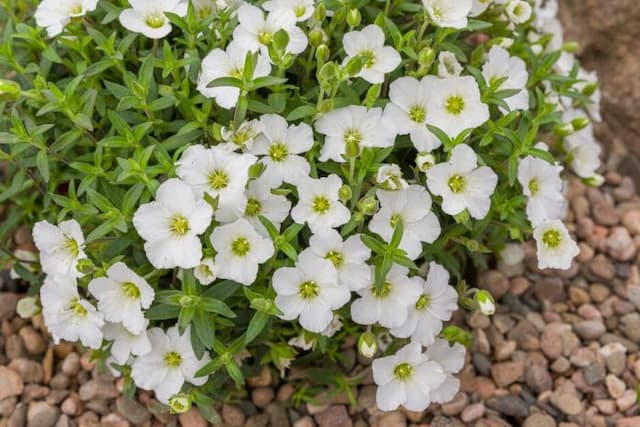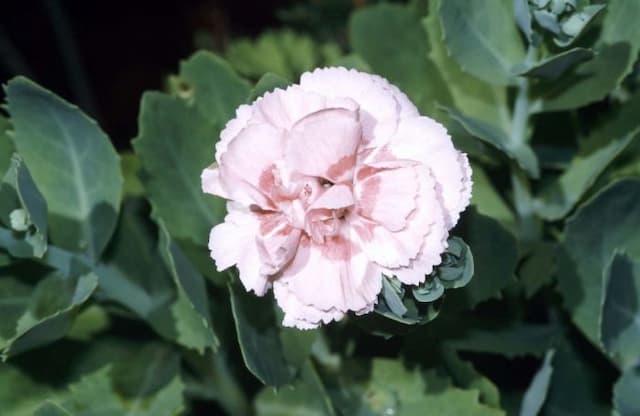Carnation Dianthus 'Alfriston' (b)

ABOUT
Dianthus 'Alfriston' is an eye-catching floral plant known for its striking blossoms and lush foliage. The flowers of this plant are renowned for their unique and intricate pattern of petals; the blooms often display a mix of bright colors, typically showcasing hues of pink, red, or purple, with contrasting rings or markings that can be white or a lighter shade of its primary color. The edges of the petals can be frilled or serrated, adding to their ornamental charm. Each flower is typically poised singularly or arranged in small clusters atop slender, yet sturdy, stems that rise above the foliage. The leaves of Dianthus 'Alfriston' are slender and bluish-green to grey-green in color, forming a dense, grass-like clump or mat. The overall effect of the blooms combined with the foliage is one of vibrant color and delicate textures, creating an appealing aesthetic that is sought after in gardens and for decorative purposes.
About this plant
 Names
NamesFamily
Caryophyllaceae
Synonyms
Carnation, Pinks, Sweet William
Common names
Dianthus 'Alfriston'
 Toxicity
ToxicityTo humans
Carnation is generally considered non-toxic to humans. Ingesting parts of the plant does not typically result in poisoning; therefore, no particular symptoms are commonly associated with carnation ingestion.
To pets
Carnation is also generally considered non-toxic to pets. It is not known to cause serious poisoning in animals, and ingestion of this plant does not typically produce harmful effects. However, as with any non-food plant, ingestion in large quantities might cause mild gastrointestinal upset in some pets.
 Characteristics
CharacteristicsLife cycle
Perennials
Foliage type
Evergreen
Color of leaves
Blue-green
Flower color
Pink
Height
1 foot [30 cm]
Spread
1 foot [30 cm]
Plant type
Herb
Hardiness zones
5
Native area
Europe
Benefits
 General Benefits
General Benefits- Attracts Pollinators: Dianthus 'Alfriston', commonly known as Pink or Carnation, draws in beneficial insects like bees and butterflies, helping to pollinate your garden.
- Low Maintenance: Pinks are quite hardy and require minimal upkeep once established, making them ideal for gardeners seeking low-maintenance plants.
- Aesthetic Appeal: With their bright, attractive flowers and pleasant fragrance, Pinks add a splash of color and scent to any garden or landscape.
- Long Bloom Season: Dianthus 'Alfriston' has a lengthy flowering period, which can last from late spring to early autumn, providing extended visual enjoyment.
- Drought Tolerance: Once established, Pinks are drought-tolerant, making them suitable for xeriscaping or gardens in dry climates.
- Versatility: This plant can be grown in borders, rock gardens, containers, and as groundcover, offering numerous landscaping possibilities.
- Cut Flowers: The blooms of Dianthus 'Alfriston' make excellent cut flowers, holding their form and color well in floral arrangements.
- Deer Resistance: Pinks are generally resistant to deer, which can help prevent damage to your garden from these browsing animals.
 Medical Properties
Medical PropertiesThis plant is not used for medical purposes.
 Air-purifying Qualities
Air-purifying QualitiesThis plant is not specifically known for air purifying qualities.
 Other Uses
Other Uses- Flower Arrangement Accent: The vivid blossoms of Carnations can be used as a striking accent in floral displays and bouquets.
- Culinary Garnish: Edible varieties of Carnations can be used to add a touch of color and decoration to desserts and salads.
- Dye Production: The petals of certain Carnations can be used to create a natural dye for fabrics or art projects.
- Bookmarks: Dried Carnation petals can be laminated onto paper to create beautiful, natural bookmarks.
- Homemade Potpourri: Dried Carnation flowers can be mixed with other herbs and spices to create fragrant potpourri.
- Religious Ceremonies: In some cultures, Carnation blooms are used as part of ceremonial offerings or decorations.
- Natural Insect Repellent: Certain components in Carnation essential oils are believed to repel insects when applied to the skin or used in sprays.
- Homemade Soaps and Candles: Carnation petals can be incorporated into homemade soaps or candles for fragrance and aesthetics.
- Art Supplies: Pressed Carnation flowers can be used in crafting, such as in scrapbooking or decoupage projects.
- Wedding Confetti: Biodegradable and colorful, Carnation petals can serve as an eco-friendly alternative to traditional confetti at weddings.
Interesting Facts
 Feng Shui
Feng ShuiThe Carnation is not used in Feng Shui practice.
 Zodiac Sign Compitability
Zodiac Sign CompitabilityThe Carnation is not used in astrology practice.
 Plant Symbolism
Plant Symbolism- Love: Dianthus flowers are often associated with love and affection. The name "dianthus" itself comes from the Greek words for divine ("dios") and flower ("anthos"), signifying the high regard in which they are held.
- Admiration: Gifting these flowers can express admiration for someone's ingenuity or resilience, given 'Alfriston' encompasses hardiness and unique beauty.
- Boldness: The striking patterns and colors of the Dianthus 'Alfriston' can symbolize boldness and daring, reflecting its standout nature in a garden.
- Purity: The bright and often white hues associated with some varieties of dianthus connote purity and innocence.
- Passion: The rich reds that can be found in dianthus are reminiscent of deep passion and heartfelt commitment.
 Water
WaterCarnations require even moisture and should be watered thoroughly when the top inch of soil feels dry to the touch. Typically, this means they may need watering once a week, but the frequency will depend on environmental conditions such as temperature and humidity. During hot, dry periods, they may need more frequent watering, possibly every 2-3 days. It's important not to overwater carnations as this can lead to root rot, so ensure good drainage. Aim to provide approximately 1 gallon of water per plant during each watering session for established plants in the ground, adjusting the amount based on the size of the plant and weather conditions.
 Light
LightCarnations thrive in full sun, so it's best to place them in a location where they will receive at least 6 hours of direct sunlight daily. A south-facing garden is usually ideal. If the plant is indoors, place it near a bright, sunny window to ensure it receives as much light as possible.
 Temperature
TemperatureCarnations prefer moderate temperatures and will do best in conditions that range from 60 to 70 degrees Fahrenheit. They can typically tolerate temperatures down to about 40 degrees Fahrenheit but should be protected from frost. During the summer, make sure they are not exposed to prolonged temperatures over 80 degrees Fahrenheit as this may cause stress to the plant.
 Pruning
PruningPrune carnations to promote bushier growth, remove spent flowers, and maintain a tidy appearance. Deadheading, or removing faded flowers, encourages further blooming and should be done regularly throughout the blooming season. At the end of the blooming season, trim back the foliage to about one-third to help revitalize the plant for the next year. The best time for more extensive pruning is in early spring, just before new growth begins.
 Cleaning
CleaningAs needed
 Soil
SoilThe best soil mix for Carnation (Dianthus 'Alfriston') is well-draining, fertile, and slightly alkaline with a pH between 6.7 and 7.5. A combination of loam, compost, and coarse sand or perlite can achieve this.
 Repotting
RepottingCarnations (Dianthus 'Alfriston') should be repotted every 1 to 2 years to refresh the soil and accommodate root growth, preferably in spring after flowering.
 Humidity & Misting
Humidity & MistingCarnations (Dianthus 'Alfriston') prefer average to low humidity levels; they thrive when the ambient humidity is around 40-50%.
 Suitable locations
Suitable locationsIndoor
Place Carnations in bright, indirect light and well-draining soil.
Outdoor
Plant Carnations in full sun with well-drained soil and space for air flow.
Hardiness zone
3-9 USDA
 Life cycle
Life cycleThe life cycle of the Dianthus 'Alfriston', also known as 'Alfriston' Carnation, begins with seed germination, which occurs in moist, well-drained soil with good sun exposure. After germination, seedlings establish themselves with a rosette of leaves at ground level. As they mature, the stems elongate and the plant enters a vegetative growth phase, producing more leaves and branching stems. The next stage is flowering, where the 'Alfriston' Carnation develops its signature pink, fragrant blossoms, attracting pollinators for reproduction. Following pollination, the plant forms seed capsules that mature and eventually release seeds, completing the life cycle. Some plants may also spread vegetatively through rooting at the nodes or by division, ensuring their survival in the garden.
 Propogation
PropogationPropogation time
Spring-Early Summer
The most popular method for propagating Dianthus 'Alfriston', commonly known as Carnation or Pink, is by taking cuttings. This is typically done in late spring to early summer. To propagate by cuttings, a gardener should choose healthy, non-flowering stems and cut a segment about 4 to 6 inches (approximately 10 to 15 centimeters) in length. The lower leaves are removed, and the cut end of the stem can be dipped in rooting hormone to encourage root development. The cutting is then planted in a well-draining soil mixture, ensuring that the soil remains consistently moist but not waterlogged. To maintain high humidity, a plastic bag or propagator can be placed over the cuttings until roots establish, which generally takes a few weeks. Once rooted, the cuttings can be transplanted to their final growing location.


![Pink [Tequila Sunrise]](/_next/image?url=https%3A%2F%2Fplants-admin.emdemapps.com%2Fimages%2Fplants%2F%2Fimages%2F604b5d995d06e.png&w=640&q=75)






